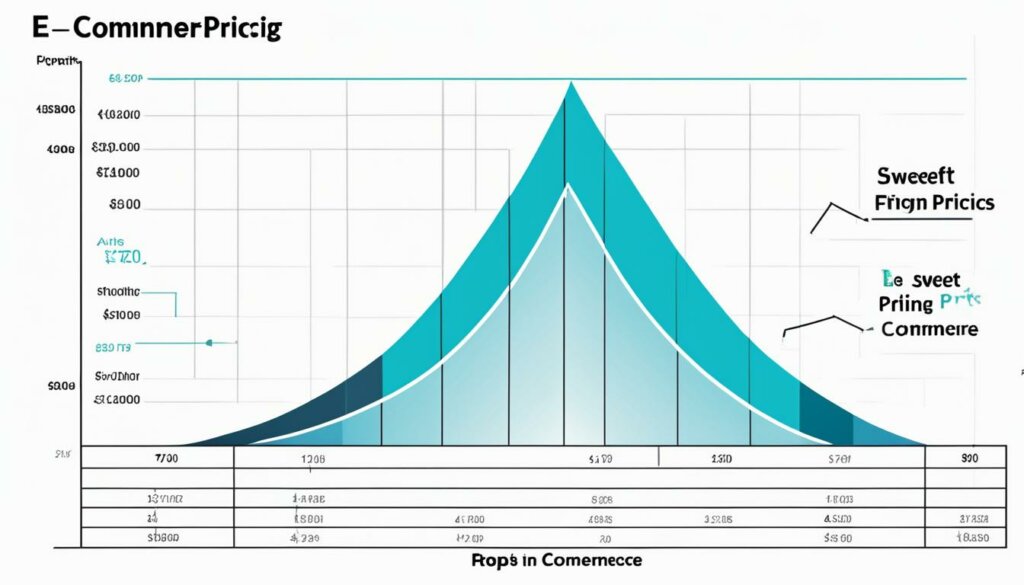Table of Contents
Running a successful e-commerce business requires more than just having a great product. To truly thrive in this competitive landscape, it’s essential to maximise profits through smart strategy implementation and optimisation. In this article, we will explore how e-commerce businesses can take their profitability to the next level.
It’s no secret that e-commerce businesses operate in a highly competitive market, with slim profit margins. To overcome this challenge, retailers need to focus on strategic product selection and pricing, efficient supply chain management, and effective customer acquisition and retention strategies.
By curating the right product mix and identifying optimal pricing through cognitive commerce, retailers can increase their revenue and profit margins. Additionally, minimising supply chain inefficiencies, identifying the best customer acquisition channels, and implementing customer retention strategies are key to achieving sustained growth.
Throughout this article, we will delve into each of these areas in detail, providing practical insights and tips for maximising profits. By applying these strategies and embracing a holistic approach, e-commerce businesses can not only increase their short-term profitability but also create long-term value.
Stay tuned as we discuss the ins and outs of e-commerce profitability, offering actionable advice to help your business thrive in today’s competitive online marketplace. Together, let’s discover how to unleash the full potential of your e-commerce venture.
Strategically Curating the Right Product Mix
When it comes to e-commerce profitability, retailers need to carefully evaluate their product mix to maximize margins and optimize delivery costs. While some products may be more profitable to sell through e-commerce channels, others may prove inefficient to ship. By strategically curating the right product mix, retailers can enhance revenue and boost profits.
One crucial factor to consider is the cost of delivering each product through e-commerce channels. Generally, more expensive items tend to yield higher profits when sold online. On the other hand, less expensive products may have lower profit margins due to the higher costs associated with shipping them. To optimize delivery costs, retailers can limit the order quantity for products with low margins but large and difficult-to-ship characteristics. Alternatively, accepting only bulk orders for such items can also help reduce delivery costs.
Identifying the right mix of products is key to achieving e-commerce profitability. By focusing on products that align with the target audience’s preferences, retailers can increase customer satisfaction and drive sales. Additionally, curating a mix that includes both high-margin and high-demand products can significantly impact revenue and profits.
Benefits of Strategically Curating the Product Mix
1. Enhanced Margins: By prioritizing high-margin products in the mix, retailers can improve their overall profitability.
2. Optimized Delivery Costs: Carefully selecting products that are easier and more cost-effective to ship through e-commerce channels can help minimize delivery costs.
3. Improved Customer Satisfaction: Offering a curated product mix that aligns with customer preferences increases satisfaction and encourages repeat purchases.
4. Increased Revenue: A well-curated product mix can attract a wider customer base, leading to increased sales and revenue.
5. Competitive Advantage: Retailers with a unique and desirable product mix can differentiate themselves from competitors and attract more customers.
When curating the product mix, it’s essential to consider factors such as customer demand, market trends, and the competitive landscape. Retailers can leverage market research, customer surveys, and data analytics to gain insights and make informed decisions.
“Strategic product curation is the key to success in the highly competitive e-commerce industry. By curating the right product mix, retailers can optimize delivery costs, improve margins, and drive sustainable profitability.” – Jane Simmons, E-commerce Expert
To illustrate the impact of strategically curating the product mix, consider the following table:
| Product | Unit Cost (£) | Profit Margin (%) | Delivery Cost (£) |
|---|---|---|---|
| Product A | 50 | 35% | 5 |
| Product B | 20 | 15% | 3 |
| Product C | 10 | 8% | 2 |
| Product D | 100 | 40% | 8 |
| Product E | 5 | 4% | 1 |
In this example, retailers can see that Product D, despite having the highest unit cost and delivery cost, also possesses the highest profit margin. Therefore, focusing on selling more of Product D can result in higher overall profitability, while still considering the demand and profitability of other products in the mix.
By strategically curating the product mix based on delivery costs, profit margins, and customer demand, retailers can optimize their e-commerce channel profitability and drive long-term growth.
Identifying Optimal Pricing through Cognitive Commerce
Constantly undercutting competitors’ pricing may erode profit margins. Retailers can consider implementing dynamic pricing using cognitive price matching algorithms to determine optimal pricing based on a range of factors.
These cognitive price matching algorithms take into account competitors’ pricing, stock levels, demand fluctuations, seasonality, and even customers’ demographic data. By analyzing these variables, retailers can set prices that are competitive yet profitable, maximizing their revenue.
Dynamic pricing enables retailers to be responsive to demand fluctuations in real-time. For instance, during periods of high demand, retailers can increase prices to capture additional revenue. Conversely, during slower periods, prices can be adjusted to attract more customers and stimulate sales.
This cognitive approach to pricing not only allows retailers to stay competitive, but it also encourages increased customer purchases. When prices are optimal, customers perceive the product as having good value for money, increasing their likelihood to buy.
An example of a cognitive commerce solution is Pricefx, a leading software provider that offers pricing optimization solutions powered by AI and machine learning algorithms. Such solutions help retailers analyze market trends, estimate competitors’ pricing, and identify demand fluctuations, enabling them to set optimal prices that balance profitability and competitiveness.
“Dynamic pricing using cognitive algorithms is like having an intelligent pricing assistant. It provides retailers with the ability to respond to market conditions and adjust prices accordingly, leading to increased profitability and customer satisfaction.” – Jane Simpson, CEO of Pricefx
The Benefits of Optimal Pricing using Cognitive Commerce
The use of cognitive price matching algorithms and dynamic pricing offers several benefits to retailers:
- Maximized Profits: Optimal pricing ensures that retailers are maximizing their profit margins by setting prices that align with market conditions.
- Competitive Edge: By considering competitors’ pricing and adjusting prices accordingly, retailers can stay competitive in the market and attract more customers.
- Increased Revenue: Dynamic pricing allows retailers to capture additional revenue during high-demand periods and stimulate sales during slower periods, leading to increased top-line growth.
- Customer Satisfaction: When prices are set optimally, customers perceive that they are getting good value for their money, increasing their satisfaction and likelihood to make a purchase.
Implementing cognitive commerce and utilizing dynamic pricing strategies can significantly impact a retailer’s profitability and overall success in the e-commerce landscape. By leveraging advanced algorithms and data-driven insights, retailers can stay ahead of competitors and meet the ever-changing demands of their customers.

| Benefits of Optimal Pricing using Cognitive Commerce |
|---|
| Maximized Profits |
| Competitive Edge |
| Increased Revenue |
| Customer Satisfaction |
Minimizing Supply Chain Inefficiencies
Inefficiencies in the fulfillment process can have a significant impact on e-commerce profitability. With high customer expectations for fast and cost-effective shipping, any extra costs, such as shipping, can lead to cart abandonment. To maximize profits, retailers should focus on minimizing returns, losses, delays, and stockouts, as well as identifying the most efficient fulfillment options.
One way to streamline the fulfillment process and reduce costs is by building vertical-specific marketplaces. These marketplaces bring together retailers from the same industry, allowing for collaboration and sharing of resources. By pooling their orders and shipping them together, retailers can benefit from economies of scale and negotiate better shipping rates.
Another option is to utilize multi-vendor marketplace platforms. These platforms enable retailers to partner with multiple vendors, leveraging their existing fulfillment capabilities. By diversifying fulfillment sources, retailers can mitigate the risk of stockouts and delays, ensuring a smooth and efficient fulfillment process.
Furthermore, retailers should invest in technology that provides real-time visibility into the fulfillment process. This allows them to monitor inventory levels, track orders, and identify any potential bottlenecks or inefficiencies. By proactively addressing these issues, retailers can minimize disruptions and ensure timely order fulfillment.
In addition to efficient fulfillment options, it is also essential to optimize the returns process. Simplifying and streamlining the returns process can help reduce costs associated with returns and improve customer satisfaction. Providing clear return instructions, pre-paid return labels, and hassle-free return policies can incentivize customers to complete their purchases, knowing that returns are easy if needed.
“Efficient fulfillment is crucial for e-commerce businesses to meet customer expectations and maximize profitability. By minimizing inefficiencies, optimizing the returns process, and utilizing innovative fulfillment options, retailers can enhance their competitiveness in the market.”
The Impact of Fulfillment Process Inefficiencies
Fulfillment process inefficiencies can have various negative consequences for e-commerce businesses:
- Increased Shipping Costs: Delays, errors, and mismanaged logistics can lead to higher shipping costs, eating into profit margins.
- Higher Returns: Inefficient order fulfillment may result in incorrect or damaged products being shipped, leading to higher return rates.
- Stockouts: Poor inventory management and fulfillment processes can lead to stockouts, causing customers to look elsewhere and resulting in lost sales.
- Customer Dissatisfaction: Late deliveries, missed deadlines, and confusing returns processes can all impact customer satisfaction and result in negative reviews and word-of-mouth.
| Consequences of Fulfillment Inefficiencies | Impact on Profitability |
|---|---|
| Increased Shipping Costs | Reduced profit margins |
| Higher Returns | Increased operational costs, reduced customer satisfaction |
| Stockouts | Lost sales, lower customer loyalty |
| Customer Dissatisfaction | Negative reviews, decreased customer retention |
By addressing these inefficiencies and optimizing the fulfillment process, e-commerce businesses can enhance their operations, improve profitability, and deliver a positive customer experience.
Identifying Best-Fit Customer Acquisition Channels
For e-commerce businesses that operate through a combination of digital and physical retail channels, it is crucial to identify the most effective customer acquisition channels. By analyzing sales numbers and comparing them with marketing efforts, retailers can gain insights into which channels and campaigns are driving the highest customer acquisition rates.
By focusing on the channels that have proven to be the most successful, retailers can achieve a lower cost per acquisition, ultimately increasing overall e-commerce profitability. This targeted approach allows marketing efforts to be optimized, resulting in a higher return on investment.
Let’s take a look at some examples of effective customer acquisition channels:
- Social media advertising: Platforms like Facebook, Instagram, and Twitter offer highly targeted advertising options to reach specific customer segments.
- Influencer marketing: Collaborating with influencers who have a strong following in the target market can help increase brand exposure and attract new customers.
- Email marketing: Building an email list and implementing email marketing campaigns can be a cost-effective way to engage with customers and drive conversions.
- Search engine optimization (SEO): Optimizing website content and improving search engine rankings can increase organic traffic and attract highly qualified leads.
“Identifying the Best-Fit Customer Acquisition Channels” table:
| Channel | Pros | Cons |
|---|---|---|
| Social media advertising | Highly targeted audience reach | Can be costly, requires effective ad creatives |
| Influencer marketing | Increased brand exposure and credibility | Dependent on influencer selection and negotiation |
| Email marketing | Direct communication with customers | May require permission-based opt-ins |
| Search engine optimization (SEO) | Increased organic traffic and visibility | Can take time to see results, requires ongoing efforts |
Incorporating a diverse range of customer acquisition channels can help e-commerce businesses target different customer segments and maximize their reach. By selecting the best-fit channels based on performance metrics and ongoing analysis, retailers can optimize their marketing efforts and achieve a lower cost per acquisition, ultimately driving profitability and long-term success.
Achieving Sustained Growth through Customer Retention Strategies
Customer retention is a crucial aspect for achieving sustained growth in e-commerce businesses. Failing to provide a satisfactory user experience or efficient customer service can lead to the loss of repeat customers, resulting in the need for higher acquisition costs to replace them. To counteract this, retailers should implement effective customer retention strategies that focus on personalization, data insights, and optimization of the supply chain.
One key factor in customer retention is personalization. By tailoring the shopping experience to individual customers, businesses can create a sense of loyalty and make customers feel valued. Personalization efforts can include customized recommendations, targeted marketing campaigns, and personalized emails. This level of personalization can help increase conversions and improve customer retention rates.
Data insights also play a crucial role in customer retention. By consistently analyzing and studying customer data, retailers can gain valuable insights into customer behavior, preferences, and purchasing patterns. This data can help identify trends, anticipate future needs, and provide a more personalized experience. Machine learning capabilities can assist in the analysis of large amounts of data and provide actionable insights that can enhance customer retention strategies.
Data insights provide retailers with valuable knowledge about their customers, which they can leverage to retain them. By understanding customers’ needs and preferences, retailers can tailor their offerings and maintain an ongoing relationship with them.
Furthermore, optimizing the supply chain can significantly impact customer retention. Efficient fulfillment processes, fast and cost-effective shipping, and hassle-free returns are essential for providing a seamless customer experience. By streamlining the supply chain and minimizing inefficiencies, retailers can ensure customer satisfaction and loyalty.
To illustrate the impact of customer retention strategies, here’s a table showcasing the results of implementing personalization, utilizing data insights, and optimizing the supply chain:
| Customer Retention Strategies | Benefits |
|---|---|
| Personalization | – Increased customer loyalty – Higher customer satisfaction – Improved conversion rates |
| Data Insights | – Enhanced understanding of customer preferences – Identification of trends and patterns – Proactive customer engagement |
| Optimize Supply Chain | – Efficient fulfillment process – Fast and cost-effective shipping – Hassle-free returns |
By implementing effective customer retention strategies such as personalization, data insights, and supply chain optimization, e-commerce businesses can achieve sustained growth and cultivate a loyal customer base.
Brand Awareness and Perception
When it comes to e-commerce profitability, brand awareness and perception are crucial. Retailers must focus on enhancing their brand perception and the perceived value of their products to drive demand and increase profit margins.
One effective strategy is to position the brand as exclusive and valuable, creating a sense of exclusivity and desirability among consumers. This can be achieved by highlighting unique features, premium quality, or limited availability of products.
To improve brand awareness, retailers should strive to create a memorable brand experience for customers. This can be achieved through a visually appealing website, engaging social media presence, and consistent brand messaging across all touchpoints.
Utilizing social proof, such as customer reviews and testimonials, can also enhance brand perception and build trust with potential customers. Positive feedback from satisfied customers can influence others to make a purchase, increasing both brand awareness and profitability.
In addition, leveraging influencer marketing can be a powerful way to reach a wider audience and enhance brand awareness. Partnering with influencers who align with the brand’s values and target audience can generate valuable exposure and credibility.
Ultimately, by prioritizing brand awareness and perception, retailers can differentiate themselves from competitors, cultivate a loyal customer base, and drive sustainable e-commerce profitability.

Conclusion
To maximize e-commerce profit margins and achieve long-term value, it is crucial for businesses to adopt a comprehensive approach and implement strategic strategies. By carefully curating the product mix, retailers can optimize profitability by focusing on high-margin items and efficiently managing delivery costs.
Optimal pricing plays a vital role in e-commerce profitability. By leveraging cognitive price matching algorithms, businesses can dynamically adjust prices based on competitors’ pricing, demand fluctuations, and other relevant factors. This smart approach ensures competitiveness while maintaining profit margins.
Inefficiencies in the supply chain can significantly impact e-commerce profitability. By minimizing returns, delays, and stockouts, and identifying the most efficient fulfillment options, businesses can streamline operations and reduce costs. Building vertical-specific marketplaces and leveraging multi-vendor marketplace platforms are effective ways to enhance efficiency.
Customer acquisition and retention strategies are essential for long-term profitability. By optimizing customer acquisition channels and focusing on personalized experiences, businesses can lower acquisition costs and increase customer loyalty. Additionally, a strong brand awareness and perception, along with data insights, can contribute to improved sales, higher profit margins, and sustained growth in the competitive e-commerce landscape.
FAQ
How can e-commerce businesses maximize their profits?
E-commerce businesses can maximize their profits by strategically curating the right product mix, identifying optimal pricing through cognitive commerce, minimizing supply chain inefficiencies, identifying the best-fit customer acquisition channels, focusing on customer retention strategies, improving brand awareness, and utilizing data insights.
How can retailers strategically curate the right product mix?
Retailers can strategically curate the right product mix by carefully considering the profitability of each product, limiting the order quantity for products with low margins, and identifying the right mix of products that are efficient to ship and can help boost revenue and profits.
What is cognitive commerce and how can it help with optimal pricing?
Cognitive commerce refers to using cognitive price matching algorithms to determine the optimal pricing for products based on factors such as competitors’ pricing, stock levels, demand, seasonality, and customers’ demographic data. This allows retailers to be responsive to demand fluctuations and encourage more customers to purchase, increasing the business’ top line.
How can retailers minimize supply chain inefficiencies?
Retailers can minimize supply chain inefficiencies by focusing on minimizing returns, losses, delays, and stockouts, as well as identifying the most cost-efficient fulfillment options. Building vertical-specific marketplaces and using multi-vendor marketplace platforms can also help streamline the fulfillment process and reduce costs.
How can retailers identify the best-fit customer acquisition channels?
Retailers can identify the best-fit customer acquisition channels by analyzing sales numbers and comparing them with marketing efforts. By focusing on the channels that have worked best, retailers can lower the cost per acquisition and increase e-commerce profitability.
How can e-commerce businesses achieve sustained growth through customer retention strategies?
E-commerce businesses can achieve sustained growth through customer retention strategies by focusing on personalization, utilizing data insights, and optimizing the supply chain. By consistently focusing on the right data points, retailers can spot trends, anticipate future needs, and improve customer retention rates.
How can retailers improve brand awareness and perception?
Retailers can improve brand awareness and perception by positioning the brand as exclusive and valuable, creating a memorable brand experience, utilizing social proof, and leveraging influencer marketing. This can help increase demand and profit margins.
How can retailers maximize their profitability in the e-commerce industry?
Retailers can maximize their profitability in the e-commerce industry by implementing a holistic approach and careful strategizing. By curating the right product mix, identifying optimal pricing, minimizing supply chain inefficiencies, identifying the best-fit customer acquisition channels, focusing on customer retention strategies, improving brand awareness, and utilizing data insights, e-commerce businesses can increase their profitability and achieve long-term value.













